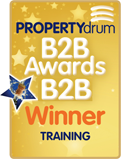How to Write a Successful Press Release
The dos and don’ts of securing meaningful publicity.
(Article for Estate Agency News)
Part of my estate agency training and publicity business involves securing effective media coverage for my clients. Whilst much of the material my clients see in print is pre-written as part of our systematic editorial programme, there are occasions when an agency wishes to secure publicity for a specific topic or project, delivered right to its target audience - be it the local population, or national readership.
It may be your agency has won an award, or has just launched a new service such as coded “For Sale” boards, on-line conveyancing, or Customer Experience Analysis, or you want to promote a new development, charity affiliation, or honour a long-serving member of staff.
Whatever the reason, you need immediate, targeted, publicity. You could of course purchase advertising space and, within reason, place what you like. However, this type of “advertorial” can look contrived and clearly biased.
Pure “editorial” is exactly that. A piece of writing that has been approved, and possibly even written, by the editor, or one of his/her journalists. Such pieces stand on their own newsworthiness and the intrinsic independence of editorial support lends a credibility that delivers far more “bang-for-your-buck” than subjective advertising ever could.
But newspaper editors are incredibly busy, focused and pressurised. Everyone wants them to carry their own preferred articles. If the editor were to publish every press release he/she receives, then the publication would jeopardise its editorial integrity and lose its way in its own competitive market.
So if you are to stand a chance of securing print coverage, you need to capture the editor’s attention with a relevant and powerful bespoke press release, and preferably one that touches on a topical issue of the day.
The problem is that 95% of all material sent to the press is not used! So here are a few pointers to consider when writing a press release in order to ensure a good chance of verbatim coverage:
1. Ask yourself - “Is this of interest to the publication’s readers?” You may be wild with excitement about your new branch opening, but will anyone else? Does the publication usually print such stories for other companies?
2. Attract the editor’s eye - Use a headline that states exactly what the release is all about. Eg: “Demand for flats prompts estate agency to open second Nottingham Office”. The editor is likely to make a decision on whether to publish or not based on this headline, even if he/she rewrites the content.
3. Keep is short and sharp. Probably about 200-250 words .
4. The first paragraph should be no more than about 50 words, contain all the who, what, when, where and why’s and be a succinct summary of the release capable of standing alone if need be. Remember - editors tend to chop from the bottom up!
5. Keep each paragraph to about four lines in depth . In publishing, a paragraph is a unit of length, not of thought. Keep it short and simple and to one side of A4. About 20-25 words per sentence and only 2 or 3 sentences per paragraph. Don’t use long words where alternative short words will do. Keep your sentences concise and avoid waffle. Always remember “Is this interesting to the reader?”
6. One-and-a-half line spacing is the norm for a clear press release and gives the editor somewhere to scribble notes. Ragged right hand margins are easier to read than justified.
7. Never, ever, try to sell! Your release will be binned. Editorial coverage is a subtle way of creating targeted awareness of a subject. It is not an advert! Stick to facts, not gratuitous selling messages.
8. Over-repetition of your name will also make the release sound like an advert. It should not be mentioned more than three times in 250 words.
9. Always write as independent third person in active voice . This makes it sound considered, informative and less “salesy”.
10. Don’t underline anything or use italics, parentheses, bold type, etc.. Your use of words should communicate what is important without embellishment.
11. Use correct English with perfect spelling, grammar and syntax.(Please contact me for a list of 22 horrendous but common writing errors and tips)
12. Date the release togive a sense of immediacy.
13. Put your contact details and web address, along with a one-line description of your unique agency approach/ethos.
14. Check, and re-read your release. Then reduce the word-count by 25%. This forces you to be economical with words!
Once you have decided on your release, find out the name of the relevant editor at the publications in which you would like your story to appear, but before sending it, consider the following:
1. A phone call first to establish the editor’s interest can be useful. But check whether it’s a good time. If they are “on deadline” phone back later. Ask when is most convenient and remember this for future use.
2. Find out how they like to receive information. Fax, post or email, but not all three. If email, most journalists prefer plain text sent in the main body of the email as opposed to an attachment.
3. When sending email press releases, make sure the subject heading is succinct and pertinent. Ideally put “as per our conversation” in the header (if it’s true).
4. A photo can help you secure a larger space on the page.
5. Editors are annoyed by a “Did you get my press release?” phone call. They will call you if they need more information. Rather call in advance of sending the release.
6. Do not ask to check the editor’s copy for factual errors. Not appreciated!
7. If you offer the piece on an “exclusive” basis, keep it so - or you’ll never appear in that paper again.
A constant drip-feed of interesting property-related press releases is a highly effective way of influencing your target audience. Please feel free to contact me if you need some content suggestions, or even a regular supply of property-related articles to augment your advertising pages.



